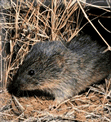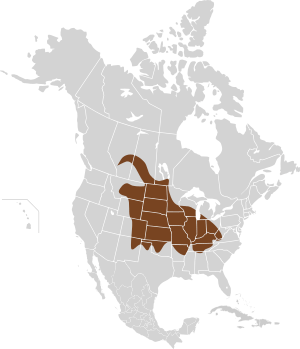Prairie vole facts for kids
Quick facts for kids Prairie vole |
|
|---|---|
 |
|
| Conservation status | |
| Scientific classification | |
| Genus: |
Microtus
|
| Species: |
ochrogaster
|
 |
|
| Synonyms | |
|
Arvicola austerus LeConte, 1853 |
|
The prairie vole (Microtus ochrogaster) is a small rodent that looks a bit like a mouse. You can find them in the central parts of North America.
These voles have long, rough fur that is grayish-brown on their backs. Their bellies are a yellowish color. They have short ears and a short tail, which is a bit darker on top.
Contents
About the Prairie Vole
The scientific name for the prairie vole is Microtus ochrogaster. This name comes from the Greek words for "small ear" (Microtus) and "yellow belly" (ochrogaster).
You can find prairie voles living in grasslands across the central United States and Canada. Their home range stretches from the eastern Rocky Mountains all the way to West Virginia. They also live north into the Canadian Prairies.
Where Prairie Voles Live
Prairie voles like to live in dry fields that have lots of grass and weeds. The biggest groups of voles are often found in fields that are not being farmed or in hay fields.
These voles dig shallow burrows and create paths, called runways, through the plants on the ground. In winter, they dig tunnels under the snow. Their runways help them stay safe from predators and find food. Prairie voles get easily scared. If they see a predator or feel threatened, they quickly hide in their burrows. They prefer drier areas compared to their relatives, the meadow voles.
Prairie Vole Behavior
Prairie voles are active all year long. When the weather is cold, they tend to be more active during the day. At other times, they are mostly active at night. Prairie voles live in groups and can show social behaviors, like humans do, when they are together.
Most prairie voles do not live longer than one or two years. How long they live depends on how many predators are around and other natural things in their environment.
Prairie voles mostly eat plants. They munch on grasses, roots, fruit, seeds, and tree bark. Sometimes, they also eat some insects. These voles are good at storing food for later. Animals that hunt prairie voles include coyotes, hawks, owls, foxes, and snakes. Sometimes, prairie voles can cause damage to garden plants and small trees.
Prairie Vole Reproduction and Life Cycle
During the mating season, male prairie voles claim their own territories. They defend these areas from other voles. They mark their territories with urine and other body fluids. If a competitor or enemy comes near, they will raise their front feet, stick their head forward, and chatter their teeth to look threatening. When it's not mating season, prairie voles live together peacefully.
Like other voles, prairie voles can have babies at any time of the year. However, the main breeding seasons are in the fall and spring. Unlike many other voles, prairie voles are usually monogamous. This means they often stay with one partner for life.
The prairie vole is a special animal to study how animals form strong social bonds. Male and female partners stay together for life, cuddle, groom each other, and share the work of building nests and raising their babies. They show a lot of friendly behavior towards each other. However, they are not always completely faithful. Even though females usually act aggressively towards unknown males, both sexes might sometimes mate with other voles if they get the chance.
The female vole is pregnant for about 20 to 30 days. Female voles usually have two to four litters each year. Each litter has two to seven babies. They make their nests in a burrow or a dip in the ground, lining it with plants. The number of babies in a litter depends on how much food is available and how old the female is. The most babies are born in spring and fall. Vole babies open their eyes about eight days after they are born. They can start feeding themselves when they are about two weeks old.
Prairie Voles and Humans
Prairie voles are an important part of the ecosystem. They provide food for many predators. However, some people consider them pests because they can damage gardens. There are several ways to stop voles from harming gardens or other areas.
You can use electric repellers or encourage natural predators like snakes, owls, coyotes, foxes, and hawks to help control vole numbers. Plastic decorations that look like predators can also scare them away.
Using poison to get rid of voles is an option, but it can be dangerous for other animals and humans. If a poisoned vole is eaten by a predator, the poison could harm the predator. Also, if poison is placed near vole entrances, other animals might reach it. Poison left in fields can also be blown away or washed away by rain. In neighborhoods, the poison itself and poisoned voles can be harmful to people and pets. If a professional pest control company is involved, they can use special bait stations outside to keep the poison safe.
Special Pair Bonding
The prairie vole is unique because it forms a strong pair bond with its partner. The male prairie vole stays in constant contact with its female partner for their entire lives. If the female vole dies, the male usually does not look for a new partner. This strong relationship is more about social closeness than just mating. For this bond to happen, the male must stay with the female for at least one day after they breed. Other vole species, like the montane vole, do not show this kind of pair bonding.
How Pair Bonding Works
This special behavior in prairie voles is linked to certain hormones called oxytocin and vasopressin. In the female prairie vole's brain, the oxytocin receptors are found more densely in the brain's reward system. They also have more of these receptors than other species. This makes the social behavior feel very rewarding, almost like an "addiction."
In male prairie voles, the gene for the vasopressin receptor has a longer section compared to the montane vole, which has a shorter section. This longer section is also found in other animals that form strong bonds, like humans. It is shorter in animals that do not form strong bonds, like chimpanzees.
Prairie Voles and Viruses
Prairie voles in Missouri have been found to carry a virus called Bloodland Lake virus (BLLV). This is a type of hantavirus. Hantaviruses can cause diseases in humans, such as Hantavirus pulmonary syndrome and Hantavirus hemorrhagic fever with renal syndrome. However, there have been no known human cases of the Bloodland Lake virus reported so far.
See also
 In Spanish: Topillos de la pradera para niños
In Spanish: Topillos de la pradera para niños


